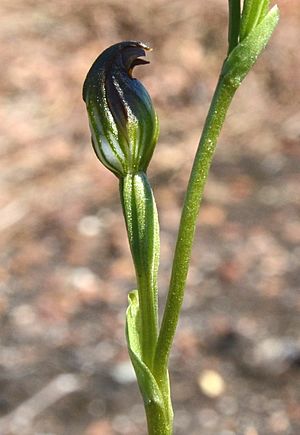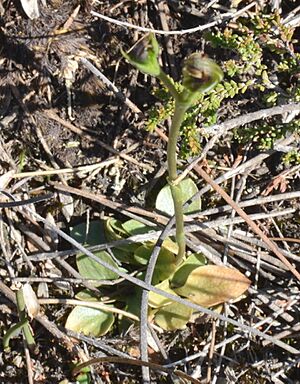Spring tiny greenhood facts for kids
Quick facts for kids Spring tiny greenhood |
|
|---|---|
 |
|
| Pterostylis vernalis near Nowra | |
| Conservation status | |
| Scientific classification | |
| Genus: |
Pterostylis
|
| Species: |
vernalis
|
| Synonyms | |
|
Speculantha vernalis D.L.Jones |
|
The spring tiny greenhood (Pterostylis vernalis) is a special type of orchid. It grows only in New South Wales, Australia. This means it is endemic to that area.
Like other greenhood orchids, this plant looks different depending on if it is flowering or not. When it's not flowering, it has a group of leaves shaped like a circle at its base. This is called a rosette. When it is flowering, it does not have this main rosette. Instead, it might have one or two rosettes on new side shoots. The flowers of this orchid are green, brown, and white. You can only find the spring tiny greenhood in a small area near Nowra.
Contents
What the Spring Tiny Greenhood Looks Like
The spring tiny greenhood is a plant that grows from the ground. It is a perennial plant, which means it lives for more than two years. It is also deciduous, so it sheds its leaves at certain times. This plant is a herb and has an underground tuber (like a small potato).
When the plant is not flowering, it has a rosette of three to seven dark green leaves. These leaves are egg-shaped. They are about 5 to 15 mm (0.2 to 0.6 in) long. They are also about 4 to 10 mm (0.16 to 0.39 in) wide.
Flowering plants can have up to four flowers. However, they do not all open at the same time. The flowers are about 8 to 10 mm (0.31 to 0.39 in) long. They are also about 4 mm (0.16 in) wide. The flowers are green with a white patch near the bottom. They are dark brown near the top.
Each flower grows on a thin, wire-like stem. This stem is about 100 to 200 mm (3.9 to 7.9 in) tall. Each flower has its own small stalk, called a pedicel. These stalks are about 1 to 9 mm (0.04 to 0.35 in) long.
The top part of the flower is called the dorsal sepal. It joins with the petals to form a hood. This hood is called a "galea." It covers the central part of the flower, which is called the column. The dorsal sepal stands up straight at its base. Then it curves forward like a half-circle. It is a little longer than the petals.
The side sepals partly close the front of the flower. They stand upright and touch the galea. Their tips are about as high as the top of the galea. The labellum is the orchid's special lip. It is about 3 to 4 mm (0.12 to 0.16 in) long. It is also about 1 to 2 mm (0.04 to 0.08 in) wide. You can barely see it from outside the flower. This orchid usually flowers in the spring.
How it Got its Name
The spring tiny greenhood was first officially described in 2006. A botanist named David Jones gave it the name Speculantha vernalis. Before this, it was known as Pterostylis sp. 'Flat Rock Creek'.
The description was published in a magazine called The Orchadian. It was based on a plant found near Flat Rock Creek Reservoir, close to Nowra. In 2010, another botanist, Gary Backhouse, changed its name to Pterostylis vernalis. The second part of its name, vernalis, is a Latin word. It means "of springtime." This is because the orchid flowers in spring.
Where the Spring Tiny Greenhood Lives
The Pterostylis vernalis usually grows in open areas. It prefers shallow, sandy soil. You can often find it near the edges of sandstone rocks. It often grows with mosses and other small plants.
Only five groups of these orchids are known to exist. All of them are found in the Nowra area.
Protecting This Orchid
The spring tiny greenhood is listed as "critically endangered." This means it is at a very high risk of disappearing forever. It is protected under the Environment Protection and Biodiversity Conservation Act 1999 (EPBC Act). It is also protected by the New South Wales Government's NSW Threatened Species Conservation Act.
There are only about 500 adult plants known. These are spread across five different groups. Only one of these groups is inside a national park. The biggest danger to this orchid is land clearing. This happens when land is cleared for buildings or other uses.



